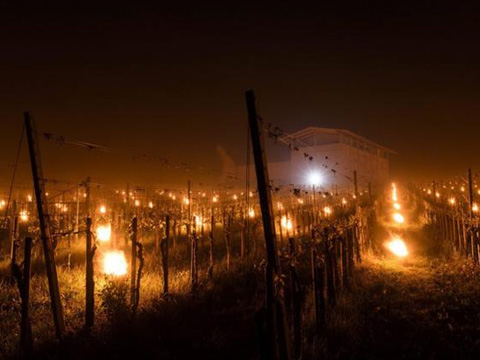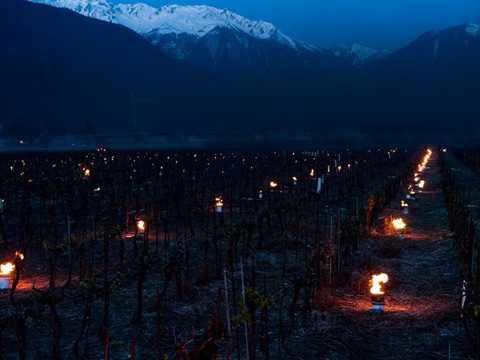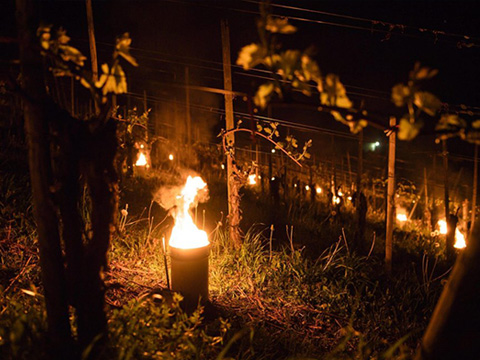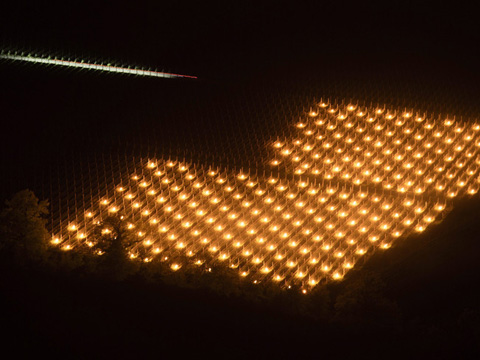Active methods of crops freeze protection
Active protection takes place just before and during the occurrence of the frost after a warning has been issued in the weather forecast. They are usually only effective under radiative frost conditions when winds are light or calm, and are most suitable in low-lying, frost prone areas. Advective freezes usually cannot be prevented by active means.
It is very important to have good forecasts of on-farm minimum temperature and wind conditions for active freeze protection. Moreover, knowledge of the critical temperatures that cause crop damage is needed. Farmers should know the nighttime temperature variations as they occur over their land and which fields are most prone to frost, so that action can be taken in these fields first. The basic concept of these methods is very simple. They either depend on the reduction of heat loss from the surface, stirring the air to break up the temperature inversion, or adding heat to maintain the temperature above the danger point.
In order to determine if it is economical to invest in the equipment, materials and labor for active freeze protection many factors must be considered. These include the degree of risk, the likely duration and severity of frosts, value of the crop, and effectiveness of the method to be used. Some of the active methods are described below.
1.Covering This method reduces heat loss from the surface. Home gardeners and growers of small acreages of low-growing commercial crops often use materials such as straw mulch, boxes, tar paper, plastic, etc. to reduce the heat loss from the surface. The cost of the materials, their storage and the time and labour needed to place the covers are the main drawbacks to this method for large areas of crops. Foams have also been used experimentally to protect plants but materials and applicators are not readily available on a commercial basis.
Some materials are more effective in reducing radiative heat loss than others. Clear plastic may transmit some long-wave radiation whereas dark, opague covers do not. Any cover is effective in reducing heat loss by convection. When covers are placed, particularly thin materials such as plastics, care must be taken to prevent contact with the plant to reduce heat loss by conduction, as the temperature of the exposed surface is usually lower than the air below it. Straw mulches should cover all plant parts as any protruding leaves are more susceptible to freeze damage. Mulches underneath plants prevent heat coming out of the soil at night from reaching these plants and thereby result in lower plant temperatures.
Covers should be removed during the day as air humidity would be higher under the cover and this would increase the danger of certain plant diseases.
2.Fog or smoke Clouds and fog are well-known for their ability to reduce radiative heat loss from the surface. Smoke from smudge pots or burning tires or refuse and mist from fine water nozzles have been used in attempts to reduce this heat loss. Since it is difficult to maintain the smoke over the sensitive crop area and to produce droplets the optimum size to intercept the long-wave radiation, this method is not very effective. In addition, our environmental laws now prohibit the use of this method, where smoke is involved.
3.Wind Machines During freezes which occur on calm, clear nights, the air layer near the ground is colder than the air aloft. This is known as a temperature inversion. Wind machines or helicopters are sometimes used to bring the warmer air down to the crop level to replace the cold air layer at the surface. This method can be effective when there are large temperature differences between air layers near the surface and those up higher. Equipment and operating costs are high. Effectiveness varies in the range of 1 to 4 degrees C.
4.Sprinkling A very low rate of application of water through irrigation can be effective in preventing freeze damage through the release of heat during cooling and freezing. Protection from freezing temperatures as low as -6°C have been reported for low growing berry and vine crops, when 1.5 to 2.5 mm per hour of water was applied.
Sprinkling of the crop should begin with the onset of freezing conditions and a film of water continuously maintained until temperatures have risen above the freezing level (0°C). If sprinkling is discontinued prematurely, heat will be drawn from leaves to melt the ice and freeze damage may result. This method creates another problem if the frost lasts too long, because the plants must be able to support the added weight of ice that builds up on the leaves and branches. A forecast of the duration that temperatures are expected to remain below freezing is very useful when using this method.
In spite of the problems, this method has proven effective for low growing crops such as strawberries, tomatoes, beans, cucumbers, peppers and squash as well as vine crops and tree fruits. It is important to recognize that this method only prevents the temperature of the protected plant from falling below the freezing point. It does not warm the plant parts nor does it raise the air temperature appreciably. Moreover, sprinklers need to provide constant, uniform coverage.
There is controversy over the use of irrigation as a protection method prior to frost occurrence. The added moisture has the beneficial effects of increasing the capacity of the soil to store heat and improving conduction of heat to the surface. Nevertheless, heating of the soil during day time is reduced because increased evaporation uses up heat energy. Moisture may also change the critical temperature which is needed to cause freeze damage to a crop. Since there are counteracting factors, a general recommendation cannot be made.
5.Heating This method is intended to add enough heat to the layer of air surrounding the crop and through radiant heat to the crop to maintain the temperature above the freezing point. Many small heaters uniformly spaced throughout the crop are the most effective in doing this. Large fires or heaters create a "chimney effect" and draw cold air in at the surface, which may create colder conditions in parts of the crop area
Fuel costs are high whether solid fuel bricks, oil or propane gas heaters are used. Capital and labour costs add to the expense and therefore only crops which have a very high value per unit area can be protected from frosts using this method. As an anti freeze candles wholesaler, we supply against frost candles for vineyard or orchard and other high value crops. They are effective to protect your crops against spring frost.
Taller crops such as grapes and tree fruits are protected most effectively. The best results occur when the air is calm, so that a steep temperature inversion exists. This method can provide protection from frost as low as -4° C.
We receive enquiries in English, Español (Spanish), Русский язык (Russian), Français (French) and العربية (Arabic). Our professional team will reply to you within one business day. Please feel FREE to contact us!

.jpg)




